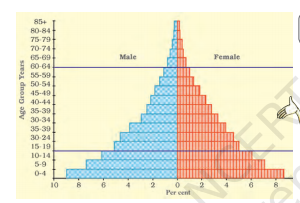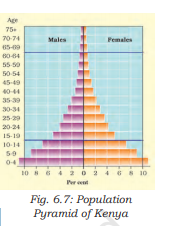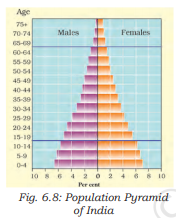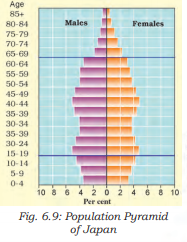According to the CBSE Syllabus 2023-24, this chapter has been renumbered as Chapter 5.
The Government of India has a Ministry of Human Resource Development. The Ministry was created in 1985 with the aim of improving people’s skills. This just shows how important people are as a resource for the country. Human resources, like other resources, are not equally distributed over the world. They differ on a range of levels, such as their educational levels, age and sex. Their numbers and characteristics also keep changing. Students can learn more about Human Resources from Chapter 6 of CBSE Class 8 Geography. One of the best resources for the students to understand the concepts and revise thoroughly for the exam is CBSE Notes Class 8 Geography Chapter 6-Human Resources.
Revising the Chapter will ensure that the student will score well on the exam. Find below in this article the link to download the CBSE Class 8 Notes from Chapter 6 of Geography.
CBSE Notes Class 8 Geography Chapter 6-Human Resources
Human Resources
People are a nation’s greatest resource. Nature’s bounty becomes significant only when people find it useful. It is people with their demands and abilities that turn them into ‘resources’. Hence, human resource is the ultimate resource.
Distribution of Population
The way in which people are spread across the earth’s surface is known as the pattern of population distribution. Over 90% of the world’s population lives on about 30% of the land surface. The distribution of the population is uneven. Some areas are crowded, and some areas are sparsely populated. The crowded areas are south and south-east Asia, Europe and northeastern North America. Very few people live in high-latitude areas, tropical deserts, high mountains and areas of equatorial forests. Many more people live north of the Equator than south of the Equator. Almost three-quarters of the world’s people live on two continents, Asia and Africa. 60% of the world’s people stay in just 10 countries. All of them have more than 100 million people.
Density of Population
The number of people living in the unit area of the Earth’s surface is the density of population- normally expressed as per square metre. The average density of the population in the whole world is 51 persons per square km. South-Central Asia has the highest density of population, followed by East and South East Asia.
Factors Affecting the Distribution of Population
Geographical Features
Topography: People prefer to live on plains rather than mountains and plateaus as these areas are suitable for farming, manufacturing and service activities.
- The Ganga plains- most densely populated areas of the world
- Andes, Alps and Himalayas—sparsely populated.
Climate: People usually avoid extreme climates that are very hot or very cold.
Examples: Sahara desert, polar regions of Russia, Canada and Antarctica.
Soil: Fertile soils provide suitable land for agriculture.
Examples: Densely populated fertile plains such as Ganga and Brahmaputra in India, Hwang-He, Chang Jiang in China and the Nile in Egypt.
Water: People prefer to live in areas where freshwater is easily available. River valleys of the world are densely populated, while deserts have a spare population.
Minerals: Areas with mineral deposits are more populated.
Example: Diamond mines in South Africa and the discovery of oil in the Middle East led to the settling of people in these areas.
Social, Cultural and Economic Factors
Social: Areas of better housing, education and health facilities are more densely populated, e.g., Pune.
Cultural: Places with religion or cultural significance attract people.
Examples: Varanasi, Jerusalem and Vatican City
Economic: Industrial areas provide employment opportunities, so it attracts a large number of people.
Examples: Osaka in Japan and Mumbai in India are two densely populated areas.
Population Change
Population change refers to a change in the number of people during a specific time. The world population is not stable. It has increased manifold due to changes in the number of births and deaths. Until the 1800s, the world’s population grew steadily but slowly. Large numbers of babies were born, but they died early too. Causes: no proper health facilities- no sufficient food available for all the people-farmers not able to produce enough to meet the food requirements of all the people. This resulted in a low increase in population. In 1804, the world population hit 1 bn, and later about 155 years later, in 1959, the population reached 3 billion-is, also known as the population explosion. Also, later in 1999, about 40 years later, the population doubled, reaching 6 billion. The main reason for this growth: better food supplies and medicine, deaths were reduced, while the number of births still remained fairly high.
Births are usually measured using the birth rate i.e. the number of live births per 1,000 people. Deaths are usually measured using the death rate, i.e. the number of deaths per 1,000 people. Migrations are the movement of people in and out of an area. Births and deaths are the natural causes of population change. The difference between the birth rate and the death rate of a country is called the natural growth rate. The population increase in the world is mainly due to a rapid increase in the natural growth rate.
Another cause for population size change- Migration. People may move within a country or between countries. Emigrants are people who leave a country; Immigrants are those who arrive in a country. Countries like the United States of America and Australia have gained in numbers by in-migration or immigration. Sudan is an example of a country that has experienced a loss in population numbers due to out-migration or emigration.
The general trend of international migrations is from the less developed nations to the more developed nations in search of better employment opportunities. Within countries, a large number of people may move from rural to urban areas in search of employment, education and health facilities.
Patterns of Population Change
Rates of population growth vary across the world- Even if the world’s total population is rising rapidly, not all countries are experiencing this growth. Kenya has a high population growth rate, as well as high birth rates and death rates. With improving health care, death rates have reduced, but birth rates still remain high leading to high growth rates. In other countries like the United Kingdom, population growth is slowing because of both low death and low birth rates.
Population Composition
Economic development has little to do with how crowded a place is. Bangladesh and Japan-densely populated. But, Japan is more economically developed than Bangladesh. People vary in age, sex, literacy level, health condition, occupation and income level. Population composition refers to the structure of the population.
The composition of the population helps to know- the number of males or females, the age group they belong to, how educated they are, what type of occupations they are employed in, and what their income levels and health conditions are. People can study the population composition of a country by looking at the population pyramid or the age-sex pyramid.
A population pyramid shows
• The total population is divided into various age groups, e.g., 5 to 9 years, 10 to 14 years.
• The percentage of the total population, subdivided into males and females, in each of those groups.

The numbers of children (below 15 years) are shown at the bottom and reflect the level of births. The size of the top shows the numbers of aged people (above 65 years) and reflects the number of deaths. The population pyramid also tells us how many dependents there are in a country. There are two groups of dependents — young dependents (aged below 15 years) and elderly dependents (aged over 65 years). Those of working age are economically active.
The population pyramid of Kenya

The population pyramid shown above for Kenya has birth and death rates both high, hence it is broad at the base and rapidly narrows towards the top. This is because although many children are born, a large percentage of them die in their infancy, relatively few become adults, and there are very few old people.
Population Pyramid of India

In countries like India, where death rates (especially amongst the very young) are decreasing, the pyramid is broad in the younger age groups because more infants survive to adulthood. This can be seen in the pyramid above for India. Such populations contain a relatively large number of young people and which means a strong and expanding labour force.

In countries like Japan, low birth rates make the pyramid narrow at the base. Decreased death rates allow numbers of people to reach old age. Skilled, spirited and hopeful young people endowed with a positive outlook are the future of any nation.
Frequently Asked Questions on CBSE Class 8 Geography Notes Chapter 6 Human Resources
What is the meaning of Human resources?
The term human resources refer to the size of the population of a country along with its efficiency, educational qualities, productivity, organisational abilities and farsightedness.
What is Economic development?
Economic Development is programs, policies or activities that seek to improve the economic well-being and quality of life for a community.
What is a population pyramid?
The population pyramid represents the breakdown of the population by gender and age at a given point in time.
Comments